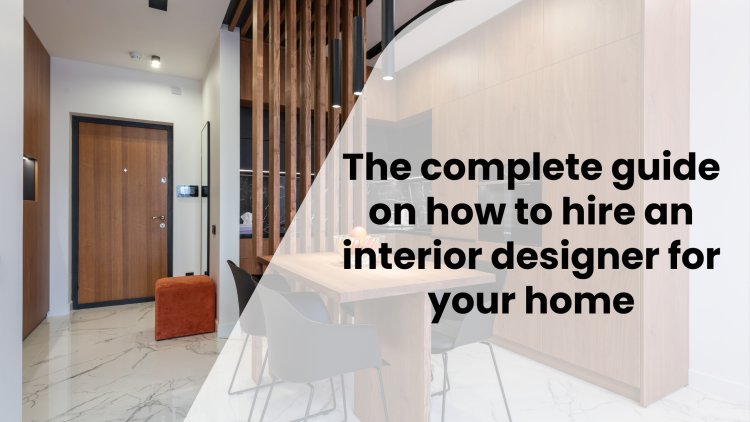The complete guide on how to hire an interior designer for your home
Creating a stylish, functional home that reflects your personality can be challenging. Many homeowners turn to interior designers for professional guidance as they consider many decisions and design elements.
Share this Post to earn Money ( Upto ₹100 per 1000 Views )

Introduction:
Creating a stylish, functional home that reflects your personality can be challenging. Many homeowners turn to interior designers for professional guidance as they consider many decisions and design elements. But how do you choose the right designer to bring your vision to life without breaking the bank? This guide will walk you through the essential steps to hiring an interior designer for your home, ensuring a smooth and successful collaboration.
Understand Your Needs:
Before diving into the world of interior design, take some time to assess your own needs and goals. What are you looking to achieve with your home’s design? Knowing the scope of your project will help you identify the type of designer you need. For instance, some designers specialize in specific styles or types of projects, such as modern minimalism or historic home restoration. Be clear about your expectations, budget, and the timeline you’re working with to help guide your search.
Research and Gather Inspiration:
Start by gathering inspiration from design magazines, Pinterest, Instagram, and home decor websites. Creating a vision board or a digital collection of your favorite designs will not only clarify your style preferences but also provide potential designers with a clear idea of what you’re aiming for. Don’t forget to make a list of your must-haves and things you’d like to avoid. This research will also give you insight into the trends, materials, and design elements that resonate with you.
Set a Realistic Budget:
Hiring an interior designer is an investment, and like any investment, it requires a clear understanding of your financial boundaries. Interior designers typically charge in several ways: by the hour, as a flat fee, or as a percentage of the project cost. Some might also offer design consultations or packages that include specific services. Make sure to discuss fees and additional costs upfront, and keep in mind that the designer’s fees are just one part of the overall budget. Include furniture, materials, and any unexpected expenses in your financial plan to avoid surprises.
Look for Qualified Designers:
Once you have a clear idea of your needs, style, and budget, it’s time to start looking for the right designer. Begin by asking for recommendations from friends, family, or colleagues who have worked with designers in the past. Online platforms like Houzz, Thumbtack, or the American Society of Interior Designers (ASID) directory can also help you find qualified professionals in your area. When evaluating potential designers, look for their portfolio, credentials, and client testimonials. A strong portfolio will showcase a designer’s range of skills and versatility, while testimonials can provide insight into their working style and reliability. Don’t hesitate to ask for references or to schedule an initial consultation to discuss your project in detail.
Interview and Assess Compatibility:
Hiring an interior designer is not just about finding someone with the right skills; it’s also about finding someone you feel comfortable working with. Schedule interviews with your top candidates to get a sense of their communication style, creativity, and approach to design. Ask about their experience with projects similar to yours, how they handle challenges, and their process for collaborating with clients. Pay attention to how well the designer listens to your ideas and whether they’re able to offer solutions that align with your vision. A good designer should be able to balance their professional expertise with your personal preferences, creating a space that reflects your taste while also being functional and beautiful.
Review Contracts and Agreements:
Once you’ve chosen a designer, the next step is to review and sign a contract. A well-drafted contract should outline the scope of work, timelines, payment schedules, and any other important details like material procurement or subcontractor management. Make sure the contract is clear on what is included and what might incur additional costs. Don’t hesitate to ask for clarifications or revisions if something doesn’t seem right.
Collaborate and Communicate:
With the contract signed, it’s time to start the design process. Effective communication is key to a successful project. Set up regular meetings or check-ins to review progress, discuss any changes, and address concerns as they arise. Be open to your designer’s suggestions they bring expertise and creative insight that can elevate your project in ways you might not have considered. After all, it’s your home, and the final design should reflect your style and needs. A collaborative relationship with your designer will lead to a more satisfying result.
Stay Flexible and Enjoy the Process:
Interior design projects often come with unexpected challenges, whether it’s a delay in materials or a change in budget. Staying flexible and open-minded will help you navigate these hurdles without unnecessary stress. Trust the process, and remember that your designer is there to guide you through each step, ensuring that the outcome is everything you envisioned.
Conclusion:
Hiring an interior designer is a smart move that can save you a great deal of time, money, and hassle. Understanding your needs, establishing a budget, and selecting the right designer will help you achieve a beautiful, yet uniquely personal, space. You will be living in your dream home within the next couple of months if you follow this guide.

 vividkreations
vividkreations 















